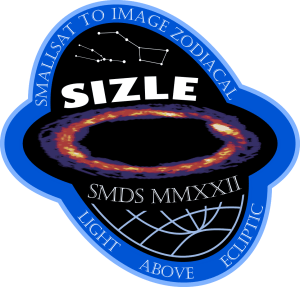 SIZLE: SmallSat to Image Zodiacal Light Above Ecliptic
SIZLE: SmallSat to Image Zodiacal Light Above Ecliptic
SIZLE will use a solar sail to maneuver into a 1AU circular orbit, inclined 30 degrees above the ecliptic plane. We will then image the zodiacal dust cloud to determine its structure and size.
Sponsors + Partner Organizations
We are very thankful for the following organizations for making this summer’s program possible!

Science Background: What is Zodiacal Light?

Interplanetary dust grains intercept and reprocess a small fraction of the solar radiation in scattered light and thermal emission. The result: the most luminous source in solar system after the sun (two orders of magnitude brighter than all the planets!). To date, our knowledge of the distribution of dust is very limited. Increasing our understanding of the asymmetries and concentrations can better inform solar system missions as collisions with this dust damage spacecraft.
Studies have shown that there are structures (dust bands, asymmetries) that result from both production mechanisms and dynamical evolution of the dust. The dust observed so far is determined to be and a mix of asteroidal and cometary in origin, but the distribution of dust beyond the astertoid belt remains largely an open question.
Mission Motivation:

No mission with imaging capability has ever left the ecliptic plane to image the zodiacal light from above. The high surface brightness of zodiacal light requires only a small aperture with moderate sensitivity. The following science goals can therefore be met with a small camera inserted into an inclined heliocentric orbit that reaches > 0.1 AU above the ecliptic plane.
Science Goals:
The SIZLE mission seeks to:
- Determine the structure of the zodiacal dust bands between Earth
and Jupiter. - Distinguish between dust bands within the total observed zodiacal
dust. - Determine which planetary objects replenish each dust band.
- Determine the dynamics of the zodiacal dust between the Earth and Jupiter.
Relevance to NASA: SIZLE addresses the following questions from the Decadal Strategy for Planetary Science and Astrobiology 2023 – 2032
-
-
- Which bodies and processes produce the smallest particles in our solar system and how do these particles evolve?
- How have collisions affected the evolution and properties of planetary bodies?
-
Mission Quad Chart
Science Traceability Matrix

Instrument payload:
The SkyFox Labs piCAM-FM camera was selected for its ability to image in both the visible and infrared, as well as its prior flight heritage. An array of 3 of these cameras shall be mounted to the spacecraft to increase both redundancy and coverage. During the science phase of the mission, the spacecraft shall capture 15 images per day (5 per camera) for 10 days above the ecliptic and 10 days below the ecliptic, with downlink to the DSN. Prior to this, some preliminary images shall be downlinked to assess functionality and calibrate the camera.

By taking images of only the background stars/galaxies, the background light can be subtracted off from the image to reveal only the zodiacal light.
Mission Overview:

The SIZLE spacecraft consists of a 47.6m x 47.6m solar sail (34kg) and an 8kg sailcraft. Control vanes on the sail shall steer the sail for an estimated 8 year cruise phase to a target circular heliocentric orbit (1AU, 30 deg inclination), followed by a 1 year operations phase.


Trajectory and Propulsion:
A solar sail was selected as it is the only viable primary propulsion option to reach the desired orbit. A minimum ΔV of 12km/s is necessary to get to 1AU, 30° inclination. From orbit insertion to arriving at the target heliocentric orbit, the journey is anticipated to take just under 8 years.




The mission requires significant technology development to enable the sail size (47.6m x 47.6m) and areal density (<15g/m^2). Prior to deployment, the solar sail shall be stowed in a 45cm x 30cm spool. Degradation of the sail material over the course of the long transit time is also a concern. Limited material data is currently available for the mission duration.
ADCS:
With pointing requirements derived from the ESA solar polar orbiter, SIZLE shall use control vanes to steer the solar sail. The number of vanes allows the spacecraft to tolerate multiple failures, and passive stability reduces jitter and power consumption. With this configuration, 0.01dps rotation rates are archievable.

A star tracker and 3-axis gyroscope is required for attitude determination. 8 stepper motors will additionally control the vanes.